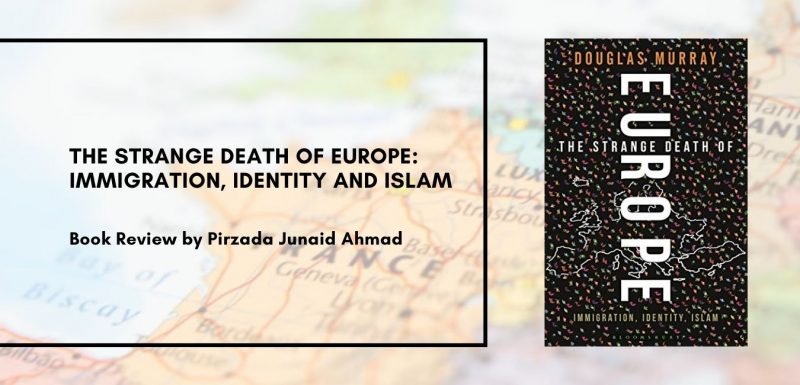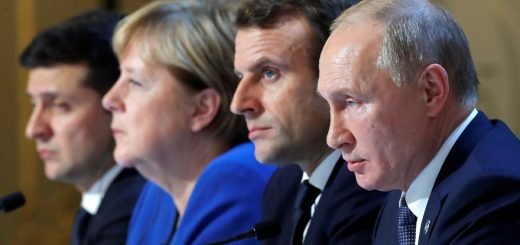The Strange Death of Europe: Immigration, Identity and Islam [Book Review]

With the ‘Arab Spring’ and the Syrian Civil-war, the European neighbourhood descended into chaos, which subsequently led to the mass migration of refugees towards Europe. It was after this wave of mass migration, that led to the subsequent refugee crises of 2015 when Douglas Murray came up with his latest book – The Strange Death of Europe: Immigration, Identity and Islam. In this book, Murray explores reasons, responses, and consequences of mass migration, especially of Muslims, towards the European countries.
Known for his anti-Islamic and neoconservative views, Douglas Murray, a British journalist and a political commentator, is one of the far-right voices in Europe since the early decade of this century. Being a vocal critique of immigration of Muslims into Europe in general, and the United Kingdom in particular, Murray has often been arguing that the acceptance of such an identity group, along with its practices, would have disastrous consequences on the European culture and society.
In his recent work, The Strange Death of Europe: Immigration, Identity and Islam, Murray asserts that “Europe is committing suicide!” and he blames this suicide on European politicians. The author hypothesises that due to the mass influx of new identities, especially Muslims, Europe, and its unique culture is facing a grave threat of survival. By highlighting how a particular identity group, along with its people, brings its customs, cultures, traditions, histories and problems, the author argues that Europe’s excessive freedom to immigrant populations to celebrate and preserve their differences will eventually bring about the dusk of European liberal culture. Being confident in his claims, the author even asserts that this ‘suicide’ is so near that “some of the present generations will see it happening in their lifetime!”
Murray highlights two main reasons for underlining his hypothesis: the first being the mass migration of non-Europeans towards Europe and Europe’s response to it, while the second is Europe’s lost faith in beliefs and traditions. While arguing for the former, he criticises supporters of immigration along the same lines along which they cherish it. For instance, he takes into account the analogy of labour shortages with respect to falling fertility rate, and greying society/adult population.
Agreeing to the fact that Europe’s fertility rate is falling below the optimum level (level necessary to avoid the decline of the population), he argues that the reason for this low fertility rate is primarily because of rising costs of living due to increased demand of housing, schools and healthcare with the increased number of immigrant settlers. By giving the example of Poland, where Justice and Law party has in recent years raised child benefits to boost the native birth rate, the author suggests that other European governments should also improve their domestic policies aiming at increasing the birth rates which would reduce the dependence on foreign immigrants in the long run.

Speaking against the supporters of immigration who argue that immigrants bring diversity to Europe, the author asks, “Shouldn’t there be a limit to diversity?” The author further argues that if Europe truly wants to encourage diversity, the Europeans should welcome more and more immigrants from other parts of the world rather than from a few third-world countries, as now Europe already has more than enough diversity of third-world culture, cuisine and way of life.
Besides, despite admitting that it is herculean to stop the migration of people in an interconnected world, the author argues that even in a globalised world, the sovereignty resides wholly within the state if it intends to apply it willingly. By highlighting how Japan has dissuaded the migrants from entering the country, he argues that Europe has made itself self-attractive by promoting a pull factor to encourage the entry of more and more migrants. The author warns that this pull factor must go if Europe has to survive.
Further, admitting that mass repatriation is a long process, filled with emotions and massive economic and diplomatic costs, he suggests that Europe should limit asylum seekers from entering the continent in the first place. He also highlights how Australia, when it faced similar crises, decided to allow only the legally deserving migrants to enter the country.
In support of the second reason behind his ‘suicide of Europe’ hypothesis, the author has argued that Christianity, which gave birth to western civilisation, has retreated in Western Europe, and has now been replaced by the ideas of liberal society and human rights. He adds that the European identity today has become more of tolerance, respect and diversity, while the historical and philosophical founding values that shaped Europe as a Christian civilisation have lost their importance.
Besides, he also argues that had this contemporary mass immigration of people been faced by a strong and cohesive European culture, it wouldn’t have been capable of posing any threat to Europe. Instead, he adds, this mass movement is witnessing a culture that is already dying, and hence these immigrants won’t do any mercy but will ensure that Europe’s death becomes promising.
Although the book carries an intriguing title – The Strange Death of Europe: Immigration, Identity, and Islam, the author has exaggerated the possible consequences that mass migration are likely to have on Europe. His proclamation of Europe’s demise also reflects that his research is selective and guided by looking at reality through a narrow perspective only. By focusing on a section of a particular identity only without giving voice to practices within the broad notion of that identity and many other identities that make the European culture, one cannot predict a reasonable and rational conclusion. After all, it is the dynamic interaction of all those identities, and sub-identities, that has shaped Europe since times.
Further, based on a few terrorist attacks that took place in western Europe in the last decade, the author, while ignoring the fact that globally Muslims have condemned those attacks, has generalised the entire identity of Muslims to be a threat to Europe. Although a group among Muslims does endorse violence, however, that group is only a minuscule minority. Hence, the author also leaves scope for comparative studies to study the nature and extent of reforms in Muslim immigrant communities post their settlement in Europe.
Besides, the author’s criticism against the rising number of immigrant children in European schools also reflects that he has neglected the positive role of diversity in schools. In contrast to the author’s criticism, the rising number of immigrant children joining European schools is a good sign for the European culture and its future, as these students would help in preserving and spreading (European) ideas of liberty, tolerance, respect, and diversity by leading the rational reforms among their societies and future generations. Also, such diversity must be encouraged so as immigrant children wouldn’t become easy targets of radical groups/organisations who may lure them for petty benefits.

Furthermore, although the importance of religion in public life has receded in Western Europe, however, religious identities take very little time to be overtly visible and binding in the face of an imminent threat. Had the migrants’ identities become such a threat to European Christian identity, as the author asserts, it would have led to the overt revival of religion in the public sphere among the European Christians.
Moreover, to avoid such problems of mass immigration from politically unstable areas, the European Union as an actor should also play a more proactive role in conflict prevention, through peaceful means in its neighbouring countries – in Near East, Eastern Europe, and North Africa. This role of European institutions has also not been explored by the author in this book.
In conclusion, one can argue that Murray is being too pessimistic and is writing from a journalistic point of view rather than an academic one. However, such proclamations about the future are a part of any culture and would continue to come. These must be seen as a mirror to reflect on the shortcomings and to address them for the future. After all, all cultures are live and dynamic! And the clash of cultures has been taking place throughout history, and these clashes pave the way to understand each other better and evolve for a better tomorrow.
Although Murray’s arguments are grounded in empirical evidence, one may find his selective research dispiriting.


















